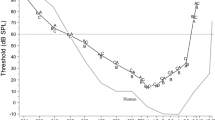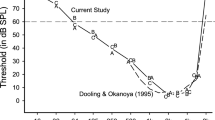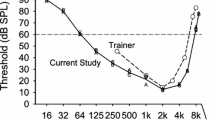Abstract
The pure-tone thresholds of three budgerigars were determined from 8 Hz to 10 kHz. At a level of 60 dB sound pressure level (re 20 μN/m2), their hearing range extends 6.6 octaves from 77 Hz to 7.6 kHz, with a best sensitivity of 1.1 dB at 3 kHz. Unlike pigeons and chickens, budgerigars do not have better low-frequency hearing than humans. This difference implies anatomical, physiological, and ecological differences between birds that hear infrasound (so far, pigeons and chickens) and those that do not (budgerigars).


Similar content being viewed by others
References
Bedard AJ Jr, Georges TM (2000) Atmospheric infrasound. Acoust Aust 28:47–52
Dent ML, Martin AK, Flaherty MM, Neilans EG (2016) Cues for auditory stream segregation of birdsong in budgerigars and zebra finches: effects of location, timing, amplitude, and frequency. J Acoust Soc Am 139:674–683. doi:10.1121/1.4941322
Dooling RJ (1973) Behavioral audiometry with the parakeet Melopsittacus undulatus. J Acoust Soc Am 53:1757–1758
Dooling R (2002) Avian hearing and the avoidance of wind turbines. National Renewal Energy Laboratory, U.S. Department of Energy. NREL/TP-500-30844. doi:10.2172/15000693
Dooling RJ, Saunders JC (1975) Hearing in the parakeet (Melopsittacus undulatus): absolute thresholds, critical ratios, frequency difference limens, and vocalizations. J Comp Physiol Psychol 88:1–20
Farabaugh SM, Dent ML, Dooling RJ (1998) Hearing and vocalizations of wild-caught Australian budgerigars (Melopsittacus undulates). J Comp Psychol 112:74–81
Hagstrum JT, Manley GA (2015) Release of surgically deafened homing pigeons indicate that aural cues play a significant role in their navigational system. J Comp Physiol A 201:983–1001
Hashino E, Sokabe M (1989) Hearing loss in the budgerigar (Melopsittacus undulatus). J Acoust Soc Am 85:289–294
Hashino E, Sokabe M, Miyamoto K (1988) Frequency specific susceptibility to acoustic trauma in the budgerigar. J Acoust Soc Am 83:2450–2452
Heffner RS, Heffner HE (1982) Hearing in the elephant: absolute sensitivity, frequency discrimination, and sound localization. J Comp Physiol Psychol 96:926–944
Heffner RS, Heffner HE (1983) Hearing in large mammals: the horse (Equus caballus) and cattle (Bos taurus). Behav Neurosci 97:299–309
Heffner HE, Heffner RS (2008) High-frequency hearing. In: Dallos P, Oertel D, Hoy R (eds) Handbook of the senses: audition. Elsevier, New York, pp 55–60
Heffner HE, Heffner RS (1995) Conditioned avoidance. In: Klump GM, Dooling RJ, Fay RR, Stebbins WC (eds) Methods in comparative psychoacoustics. Birkhäuser, Basel, pp 73–87
Heffner HE, Koay G, Hill EM, Heffner RS (2013) Conditioned suppression/avoidance as a method for testing hearing in birds: the domestic pigeon (Columba livia). Behav Res Methods 45:383–392
Hill EM, Koay G, Heffner RS, Heffner HE (2014) Audiogram of the chicken (Gallus gallus domesticus) from 2 Hz to 9 kHz. J Comp Physiol A 200:863–870
Hoffman HS (1960) A flexible connector for delivering shock to pigeons. J Exp Anal Behav 3:330
Jackson LL, Heffner RS, Heffner HE (1999) Free-field audiogram of the Japanese macaque (Macaca fuscata). J Acoust Soc Am 106:3017–3023
Kreithen ML, Quine DB (1979) Infrasound detection by the homing pigeon: a behavioral audiogram. J Comp Physiol A 129:1–4
Okanoya K, Dooling RJ (1987) Hearing in passerine and psittacine birds: a comparative study of masked and absolute auditory thresholds. J Comp Psychol 101:7–15
Saunders JC, Dooling RJ (1974) Noise-induced threshold shift in the parakeet (Melopsittacus undulatus). Proc Natl Acad Sci 71:1962–1965
Saunders JC, Pallone R (1980) Frequency selectivity in the parakeet studied by isointensity masking contours. J Exp Biol 87:331–342
Saunders JC, Else PV, Bock GR (1978) Frequency selectivity in the parakeet (Melopsittacus undulatus) studied with psychophysical tuning curves. J Comp Physiol Psychol 92:406–415
Saunders JC, Rintelmann WF, Bock G (1979) Frequency selectivity in bird and man: a comparison among critical ratios, critical bands, and psychophysical tuning curves. Hear Res 1:303–323
Stein N, Hoffman HS, Stitt C (1971) Collateral behavior of the pigeon during conditioned suppression of key pecking. J Exp Anal Behav 15:83–93
Acknowledgments
We thank Kellie Marchetto for her help with the behavioral testing. The use of animals in this study was approved by the University of Toledo Animal Care and Use Committee.
Funding was provided by The University of Toledo Foundation Sarno Memorial Research Fund.
Author information
Authors and Affiliations
Corresponding author
Rights and permissions
About this article
Cite this article
Heffner, H.E., Koay, G. & Heffner, R.S. Budgerigars (Melopsittacus undulatus) do not hear infrasound: the audiogram from 8 Hz to 10 kHz. J Comp Physiol A 202, 853–857 (2016). https://doi.org/10.1007/s00359-016-1125-9
Received:
Revised:
Accepted:
Published:
Issue Date:
DOI: https://doi.org/10.1007/s00359-016-1125-9




